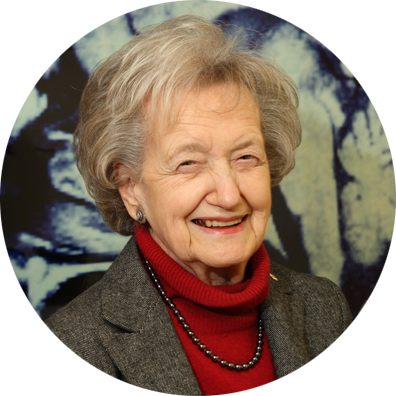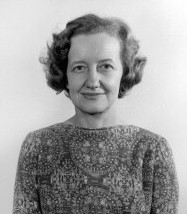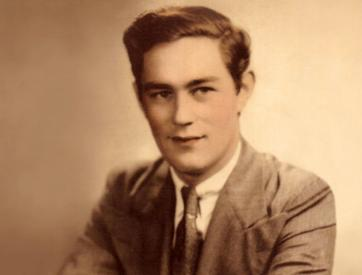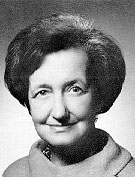« Je reste très curieuse, vous savez. De tout. » / "I remain very curious, you know. Of everything."

Brenda Milner, pionnière de la recherche sur le cerveau humain, est la plus illustre neuropsychologue du Canada. Celle que beaucoup considèrent comme une fondatrice du domaine de la neuropsychologie clinique et des neurosciences cognitives est professeure titulaire de la Chaire Dorothy J. Killam à l’Institut et hôpital neurologiques de Montréal (le Neuro) et professeure au Département de neurologie et neurochirurgie. Ses travaux ont révolutionné notre compréhension de la façon dont les structures du cerveau gèrent différentes fonctions d’apprentissage, de la mémoire et du langage. Elle a reçu nombre de prestigieux prix et distinctions. Son parcours professionnel hors du commun s’étend sur plus de 70 ans – dont 60 au sein de la communauté du Neuro et de McGill, où elle a dirigé le Laboratoire de recherche en neuropsychologie et a enseigné au Département de neurologie et neurochirurgie. Elle célèbre son 100e anniversaire en juillet 2018 et continue d’enseigner et de réaliser de la recherche au Neuro.
Les premières années
« N’hésitez pas à changer de carrière lorsqu’elle ne convient pas. Je pourrais être une médiocre prof de math au secondaire aujourd’hui »Brenda (Langford) Milner naît à Manchester, en Angleterre le 15 juillet 1918. Son père était critique musical et sa mère enseignait la musique. L’enfant curieuse et intellectuellement précoce a dès six ans une bonne maîtrise de l’allemand et apprend le français de sa mère. En 1936, elle s’inscrit à l’Université de Cambridge en mathématiques et comprend vite « que je ne m’y illustrerais jamais ». Tout en restant sensible au raisonnement et à la sophistication des mathématiques, elle opte pour la psychologie et aura la réflexion suivante : « N’hésitez pas à changer de carrière lorsqu’elle ne convient pas. Je pourrais être une médiocre prof de math au secondaire aujourd’hui ». Le Département de psychologie à Cambridge était fortement orienté vers la physiologie et partageait des espaces de travail avec le réputé physiologiste Lord Edgar Adrian. C’est durant ses études sous la supervision du docteur Oliver Zangwill à Cambridge que Brenda Milner apprend la valeur d’étudier les lésions au cerveau et la possibilité d’examiner des troubles cognitifs afin de mieux comprendre le fonctionnement du cerveau normal.

Madame Milner entreprend une maîtrise en psychologie expérimentale à Cambridge, qui deviendra un projet au profit de l’effort de guerre britannique en 1939. Au lieu de poursuivre sa recherche initiale sur les réactions à un traitement erroné de l’information sensorielle, elle intègre une équipe qui s’intéresse à distinguer par des tests d’aptitude des pilotes d’avions de chasse et d’avions de bombardement. Durant la Deuxième Guerre mondiale, elle travaille au ministère des Approvisionnements de la Grande-Bretagne, où elle rencontre son futur mari, Peter Milner. Pendant qu’elle effectue sa maîtrise à Cambridge, en 1944, ils partent pour le Canada, où Peter, un ingénieur électricien – devenu plus tard un neuropsychologue – a été invité à travailler avec des physiciens en recherche atomique. Une fois à Montréal, Madame Milner entre à l’Institut de psychologie de l’Université de Montréal, où elle enseignera pendant sept ans.
« j’ai tout de suite su que je voulais m’y investir à fond, quelles que soient les difficultés pratiques. »En 1950, elle reprend ses études à l’Université McGill au Département de psychologie. Sous la direction de Donald Hebb, elle explore les effets intellectuels de lésions au lobe temporal chez les humains, et reçoit un doctorat en 1952. Le professeur Hebb lui obtient un poste permanent en recherche avec le docteur Wilder Penfield au Neuro pour étudier des patients épileptiques. Elle décide de poursuivre ces travaux, malgré la mise en garde que lui adresse le professeur Hebb, selon qui une psychologue ne durerait pas longtemps au sein d’un institut neurologique. Elle racontera que dès le début de ses travaux à l’INM « j’ai tout de suite su que je voulais m’y investir à fond, quelles que soient les difficultés pratiques. » Ce sont ces travaux au Neuro qui forgent sa réputation et qui amènent le neurochirurgien William Beecher Scoville, de Hartford, au Connecticut, à l’inviter à venir y étudier un patient désigné par ses initiales, H.M
Le patient H.M.
 Henry Molaison.
Henry Molaison.
La contribution considérable de Madame Milner à la compréhension scientifique de la structure du cerveau humain est en grande partie attribuable aux études à long terme, rigoureuses et méthodiques, qu’elle a réalisées auprès de patients avant et après des résections au cerveau bien documentées. En 1955, elle rencontre Henry Molaison, le fameux H.M., un homme de 29 ans du Connecticut qui a subi une ablation expérimentale de parties du cerveau afin de soulager ses crises aiguës d’épilepsie. Si le résultat est concluant, l’opération a des effets fâcheux; il restera incapable d’inscrire dans sa mémoire à long terme de nouveaux événements. Dès que son attention était distraite, Henry n’arrivait pas à se souvenir d’événements précédents. Durant les plus de 30 ans qu’ont duré leurs contacts, Molaison n’a jamais retenu le nom de la professeure Milner.
« Constater que H.M. avait appris la tâche à la perfection, mais sans avoir conscience de l’avoir déjà réalisée a été une illustration fascinante de dissociation. Voilà un moment extraordinaire dans ma vie »Les expériences minutieuses de madame Milner avec Molaison lui ont permis d’observer que s’il ne se rappelait pas avoir appris des tâches précises, il arrivait à améliorer leur exécution, montrant ainsi que sa mémoire procédurale était intacte. Il se souvenait de la façon d’effectuer certains exercices de dessin, bien qu’il n’ait aucun souvenir de les avoir appris; c’est là une démonstration convaincante que la mémoire rétrospective est distincte des autres fonctions de la mémoire. « Constater que H.M. avait appris la tâche à la perfection, mais sans avoir conscience de l’avoir déjà réalisée a été une illustration fascinante de dissociation. Voilà un moment extraordinaire dans ma vie », confie-t-elle. Le concept de multiples systèmes de mémoire était sans précédent à l’époque et a suscité un grand nombre de recherches à l’échelle internationale.
L’étude du cas de Molaison par Brenda Milner constitue un des premiers exemples de recherche en neurosciences cognitives, avant même que le domaine soit établi. L’un des objectifs importants des neurosciences cognitives est d’associer structures et fonctions cérébrales, comme l’a fait la professeure Milner en montrant le rôle clé des lobes temporaux du cerveau dans la mémoire. L’article de 1957 (Scoville and Milner, 1957), concernant les résultats de ses travaux sur la mémoire, est l’une des publications les plus citées en neurosciences.
Autres activités de recherche
La consécration de l’importance des travaux de la professeure Milner avec les patients des docteurs Penfield et William Scoville a inauguré une nouvelle ère de neuropsychologie à l’INM. Theodore Rasmussen, conscient des nuances des tests psychométriques, a commencé à coordonner la tenue de ses opérations avec la disponibilité de la professeure Milner, afin de lui accorder assez de temps pour étudier soigneusement ses patients avant et après leur opération. Au cours des années suivantes, Milner a réalisé plusieurs études influentes en identifiant les régions du cerveau qui interviennent dans le langage, le bilinguisme et la mémoire spatiale. On lui doit le recours à l’amytal sodique pour inactiver temporairement des parties du cerveau de façon à évaluer les processus de la mémoire d’un patient avant une intervention chirurgicale. Aujourd’hui, la méthode est couramment utilisée de par le monde.
 En 1989, la professeure Milner et son collègue, Michael Petrides, ont obtenu une importante subvention McDonnell-Pew afin d’établir un centre de neurosciences cognitives au Neuro, ce qui a favorisé une relation étroite entre l’unité de neuropsychologie et la toute nouvelle unité d’imagerie cérébrale du Neuro. En 1990, elle a quitté ses fonctions en tant que directrice de l’Unité de recherche en neuropsychologie/neurosciences cognitives du Neuro, afin de réaliser de la recherche à titre de professeure Dorothy J. Killam de psychologie de l’Université McGill. Elle a également encadré les études et les recherches de plus d’une douzaine d’étudiants des cycles supérieurs.
En 1989, la professeure Milner et son collègue, Michael Petrides, ont obtenu une importante subvention McDonnell-Pew afin d’établir un centre de neurosciences cognitives au Neuro, ce qui a favorisé une relation étroite entre l’unité de neuropsychologie et la toute nouvelle unité d’imagerie cérébrale du Neuro. En 1990, elle a quitté ses fonctions en tant que directrice de l’Unité de recherche en neuropsychologie/neurosciences cognitives du Neuro, afin de réaliser de la recherche à titre de professeure Dorothy J. Killam de psychologie de l’Université McGill. Elle a également encadré les études et les recherches de plus d’une douzaine d’étudiants des cycles supérieurs.
Ces vingt dernières années, deux thèmes ont orienté les recherches de Madame Milner : la façon dont le cerveau de personnes bilingues gère le langage, et la façon dont les structures du lobe temporal médian du cerveau permettent à la mémoire de repérer des objets et de reconnaître les caractéristiques d’un objet. De concert avec sa collègue, Denise Klein, elle a eu recours à l’imagerie cérébrale afin d’examiner si la performance dans une langue seconde fait intervenir les mêmes substrats neuronaux que pour une langue première. D’autres de ses études ont révélé l’importance de la région hippocampique droite dans la mémoire spatiale. Ses recherches ont aussi démontré comment le cortex frontal du cerveau place de récents événements en ordre temporel. Ces travaux permettent de mieux comprendre la relation entre les structures du langage et la prédominance de la main droite ou de la main gauche.
Les récentes années
 Ces dernières années, Madame Milner a occupé une place de plus en plus éminente dans l’espace public, par les nombreuses interviews qu’elle a accordées à la télévision, à la radio, à des émissions baladodiffusées, aux journaux et à des magazines. Elle est devenue l’une des scientifiques les plus connues du Québec et du Canada, ici et à l’étranger, en partie à cause des reportages que consacrent les médias nationaux et internationaux à sa carrière et à ses recherches. Elle a été invitée à prononcer certaines des conférences les plus prestigieuses en science. Mentionnons notamment celle qui décrivait ses travaux novateurs sur la mémoire à l’occasion du Congrès mondial sur le cerveau, le comportement et les émotions tenu en 2014 à Montréal, et la Conférence initiale du gouverneur général à l’Université Queen’s, à Kingston, en 2005.
Ces dernières années, Madame Milner a occupé une place de plus en plus éminente dans l’espace public, par les nombreuses interviews qu’elle a accordées à la télévision, à la radio, à des émissions baladodiffusées, aux journaux et à des magazines. Elle est devenue l’une des scientifiques les plus connues du Québec et du Canada, ici et à l’étranger, en partie à cause des reportages que consacrent les médias nationaux et internationaux à sa carrière et à ses recherches. Elle a été invitée à prononcer certaines des conférences les plus prestigieuses en science. Mentionnons notamment celle qui décrivait ses travaux novateurs sur la mémoire à l’occasion du Congrès mondial sur le cerveau, le comportement et les émotions tenu en 2014 à Montréal, et la Conférence initiale du gouverneur général à l’Université Queen’s, à Kingston, en 2005.
En 2007, l’illustre scientifique a créé, en faisant un don majeur, la Fondation Brenda Milner afin de soutenir des chercheurs postdoctoraux en neurosciences cognitives au Neuro. L’American Psychological Association (APA) a créé le Brenda A. Milner Award qui récompense le meilleur article en neurosciences du comportement rédigé par un récent titulaire d’un doctorat. Grâce à ces initiatives, le nom de la professeure Milner continuera de résonner dans la communauté neuroscientifique durant de nombreuses années.
Brenda Milner, a pioneer in human brain research, is Canada's foremost neuropsychologist. The woman who many consider a founder of the field of clinical neuropsychology and cognitive neuroscience is Dorothy J. Killam Professor at the Montreal Neurological Institute and Hospital (the Neuro) and Professor in the Department of Neurology and Neurosurgery. His work has revolutionized our understanding of how brain structures manage different learning functions, memory and language. She has received many prestigious awards and honours. Her extraordinary professional career spans more than 70 years - 60 of which were spent in the Neuro and McGill communities, where she directed the Neuropsychology Research Laboratory and taught in the Department of Neurology and Neurosurgery. She celebrates her 100th birthday in July 2018 and continues to teach and conduct research at the Neuro.
The early years
"Feel free to change careers when they are not appropriate. I could be a mediocre high school math teacher today. "Brenda (Langford) Milner was born in Manchester, England on July 15, 1918. His father was a music critic and his mother taught music. The curious and intellectually precocious child has a good command of German from the age of six and learns French from his mother. In 1936, she enrolled at Cambridge University in Mathematics and quickly realized that "I would never do well there. While remaining sensitive to the reasoning and sophistication of mathematics, she opted for psychology and would consider the following: "Feel free to change careers when it is not appropriate. I could be a mediocre math teacher in high school today. The Department of Psychology in Cambridge was strongly oriented towards physiology and shared workspaces with the renowned physiologist Lord Edgar Adrian. It is during her studies under the supervision of Dr. Oliver Zangwill in Cambridge that Brenda Milner learned the value of studying brain damage and the possibility of examining cognitive disorders in order to better understand how the normal brain works.
Ms. Milner undertook a master's degree in experimental psychology at Cambridge, which became a project for the British war effort in 1939. Instead of continuing her initial research on reactions to incorrect processing of sensory information, she joined a team interested in distinguishing between fighter and bombing aircraft pilots through aptitude tests. During the Second World War, she worked at the British Ministry of Supply, where she met her future husband, Peter Milner. While completing her master's degree at Cambridge in 1944, they moved to Canada, where Peter, an electrical engineer - later a neuropsychologist - was invited to work with physicists in atomic research. Once in Montreal, Ms. Milner entered the Institute of Psychology at the University of Montreal, where she taught for seven years.
"I knew right away that I wanted to be fully involved in it, whatever the practical difficulties. "In 1950, she resumed her studies at McGill University in the Department of Psychology. Under the direction of Donald Hebb, she explored the intellectual effects of temporal lobe injury in humans and received a doctorate in 1952. Professor Hebb obtained him a permanent research position with Dr. Wilder Penfield at the Neuro to study epileptic patients. She decided to continue this work, despite Professor Hebb's warning that a psychologist would not last long in a neurological institute. She will tell us that from the very beginning of her work at the INM, "I knew right away that I wanted to be fully involved in it, whatever the practical difficulties. "It is this work at the Neuro that forges his reputation and leads neurosurgeon William Beecher Scoville, of Hartford, Connecticut, to invite him to come and study a patient named by his initials, H.M
The H.M. patient
(Henry Molaison, HM patient, pictured in 1950'sHenry Molaison.)
Dr. Milner's significant contribution to the scientific understanding of the structure of the human brain is largely due to the rigorous and systematic long-term studies she has conducted with patients before and after well-documented brain resections. In 1955, she met Henry Molaison, the famous H.M., a 29-year-old man from Connecticut who underwent an experimental removal of parts of the brain to relieve his acute epileptic seizures. If the result is conclusive, the transaction has unfortunate effects; he will not be able to record new events in his long-term memory. As soon as his attention was distracted, Henry could not remember previous events. During the more than 30 years of their contacts, Molaison never retained Professor Milner's name.
"To find that H.M. had learned the task to perfection, but without being aware that he had already done it, was a fascinating illustration of dissociation. There was an extraordinary moment in my life "Mrs. Milner's careful experiences with Molaison allowed him to observe that if he did not remember learning specific tasks, he could improve their execution, thus showing that his procedural memory was intact. He remembered how to perform certain drawing exercises, although he has no memory of learning them; this is a convincing demonstration that retrospective memory is distinct from the other functions of memory. "To find that H.M. had learned the task to perfection, but without being aware that he had already done it, was a fascinating illustration of dissociation. This is an extraordinary moment in my life," she says. The concept of multiple memory systems was unprecedented at the time and generated a great deal of international research.
Brenda Milner's Molaison case study is one of the first examples of research in cognitive neuroscience, even before the field was established. One of the important objectives of cognitive neuroscience is to associate brain structures and functions, as Professor Milner did by showing the key role of the brain's temporal lobes in memory. The 1957 article (Scoville and Milner, 1957), concerning the results of his work on memory, is one of the most cited publications in neuroscience.
Other research activities
The recognition of the importance of Professor Milner's work with patients of Drs. Penfield and William Scoville ushered in a new era of neuropsychology at the NJI. Theodore Rasmussen, aware of the nuances of psychometric tests, began to coordinate the conduct of his operations with Professor Milner's availability, in order to allow her enough time to carefully study her patients before and after their surgery. In the following years, Milner conducted several influential studies identifying the regions of the brain that are involved in language, bilingualism and spatial memory. He is credited with using sodium amytal to temporarily inactivate parts of the brain in order to evaluate the processes in a patient's memory before surgery. Today, the method is widely used throughout the world.
In 1989, Professor Milner and her colleague, Michael Petrides, received a major McDonnell-Pew grant to establish a cognitive neuroscience centre at the Neuro, which fostered a close relationship between the neuropsychology unit and the newest brain imaging unit at the Neuro. In 1990, she left her position as Director of the Neuro Neuropsychology/Cognitive Neurosciences Research Unit to conduct research as Dorothy J. Killam Professor of Psychology at McGill University. She has also supervised the studies and research of more than a dozen graduate students.
Over the past twenty years, Dr. Milner's research has focused on two themes: how the brains of bilingual people manage language, and how the structures of the median temporal lobe of the brain allow memory to locate objects and recognize the characteristics of an object. Together with her colleague, Denise Klein, she used brain imaging to examine whether performance in a second language involves the same neural substrates as for a first language. Other of his studies have revealed the importance of the right hippocampal region in spatial memory. His research has also shown how the frontal cortex of the brain places recent events in temporal order. This work provides a better understanding of the relationship between language structures and the predominance of the right or left hand.
The recent years
In recent years, Ms. Milner has become increasingly prominent in the public arena, through the many interviews she has given to television, radio, podcasts, newspapers and magazines. She has become one of the best-known scientists in Quebec and Canada, both here and abroad, partly because of the coverage of her career and research in the national and international media. She has been invited to give some of the most prestigious conferences in science. These include the one that described his groundbreaking work on memory at the 2014 World Congress on Brain, Behaviour and Emotions in Montreal, and the Governor General's Initial Conference at Queen's University in Kingston in 2005.
In 2007, the illustrious scientist made a major donation to the Brenda Milner Foundation to support postdoctoral researchers in cognitive neuroscience at the Neuro. The American Psychological Association (APA) created Brenda A. Milner Award for the best behavioural neuroscience article written by a recent PhD graduate. Through these initiatives, Professor Milner's name will continue to resonate in the neuroscience community for many years to come.